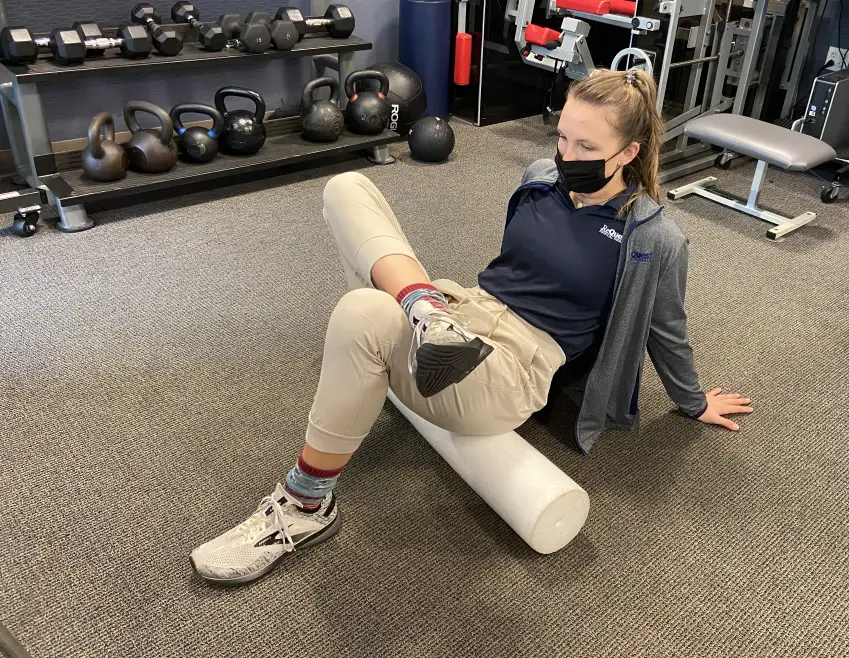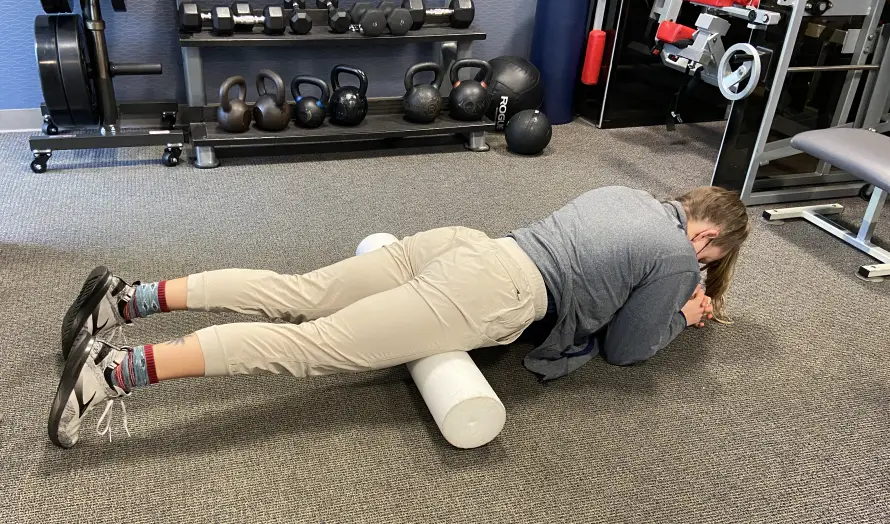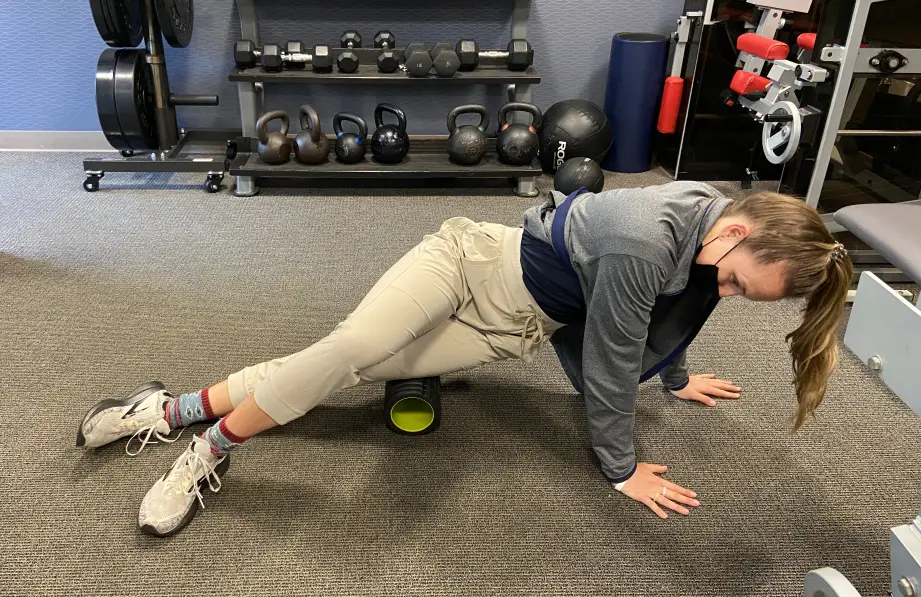If you have been to a gym in the past decade, you have inevitably seen foam rolling. Foam rollers have evolved from long white cylinders to brightly colored tubes that vary in texture, density and length.
The list of proposed benefits of foam rolling is long. Gaiam, one of the major brands in workout recovery tools, claims that their foam rollers “target muscles through something called myofascial release, a soft tissue therapy that relaxes contracted muscles, improves blood and lymphatic circulation, and stimulates the stretch reflex.”
TriggerPoint, another maker of foam rollers, included improved quality of your sleep as a good reason to roll out. But are these claims valid? What does current scientific evidence say about foam rolling and muscle soreness? Let’s take a look!
What is foaming rolling?
Foam rolling is a type of self-myofascial release. To roll out a body part, you position yourself on top of the roller, and then you use your own body weight to create pressure through the target tissues. It can be used as part of a warm-up or cooldown.
Most models are made of a hard plastic cylinder that is covered by a layer of dense foam. Older models can be a bit more comfortable as they are made entirely of foam. Foam rolls are generally six inches in diameter and can be textured to increase the depth of pressure or stimulation of the nervous system.
The goals of foam rolling are to:
- decrease muscle tension and soreness
- restore flexibility and range of motion
- help you move better

Foam rolling the hamstrings. (Photo by Penny Goldberg.)
How does foam rolling work?
There are several proposed mechanisms for the post-exercise soreness that is commonly known as delayed onset muscle soreness (DOMS). There may be as many as six different theories on how and why DOMS occurs, including lactic acid, muscle spasm, tissue damage, inflammation, and enzyme theories.
Fatigue during exercise is well-correlated with the accumulation of lactate, but it’s not likely a primary cause. After exercise, lactate in the blood is thought to be removed by using recovery methods that increase blood flow, but current scientific evidence does not support this idea.
Using a foam roller compresses your tissues, which creates the vasodilation and increased circulation to clear metabolic byproducts. Also, research has shown that it doesn’t really matter what type of foam roller you use in reducing muscle soreness and clearing lactate.
When it comes to increasing flexibility, pain modulation is key to get the relief you want. Applying pressure to the painful area stimulates the central nervous system via receptors in the skin. When these pressure receptors are stimulated, the pain sensation is effectively blocked and tolerance to stretching improves.
A 2019 meta-analysis investigated the effects of foam rolling on performance and recovery. Researchers found that using foam rolling prior to performance can improve sprint performance and flexibility but has a negligible effects on jumping and strength activities.
In terms of recovery, using the foam roll after exercise seemed to cause a small reduction in pain. But no one yet knows if other types of exercise, such as long-distance running and court and field sports.
Lastly, it seems that foam rolling where you put your body weight through the roller rather than a roller massage tool where you use your hands to roll a specific area (such as these) offers larger effects on recovery.
Hendricks et al. were a bit more conclusive in their 2020 systematic review that set out to guide practitioners on how to apply foam rolling into an exercise routine. They noted that foam rolling should be a part of a robust warm-up program (that also includes dynamic stretching and active warm-up) as it reduces muscle stiffness and increases range of motion.
Post-workout rolling showed reductions in DOMS and improved pain pressure threshold. Possibly the most important message from this study is that several of the studies that showed large effects from foam rolling instructed participants to apply as much pressure as possible to the affected area.
Why do I feel sore after foam rolling?
No one really knows for sure why some people feel better (or not) after they foam roll or how the foam rolling mechanism works. However, the effects of foam rolling is similar to a deep tissue massage in terms of discomfort and soreness. This is often described as a “good pain” or pain that “hurts so good.”
According to Dr. Aynollah Naderi, Assistant Professor of Physical Education at Shahrood University of Technology in Semnan, Iran, foam rolling can be uncomfortable for those with stiff muscles but also when it is use incorrectly.
“If a person using the roller uses too much weight through the roller, rolls too fast, or stays in one area for too long, the result can be more soreness,” Naderi said. “The usual application frequency is 30 rolling cycles per minute for two minutes.”
The other reasons foam rolling is painful are less clear. The presence of trigger points and the ability to detect them if present is a controversial topic. There is some evidence that manual pressure (in this case from the tool rather than a hands-on technique) seems to decrease pain and improve function, but it’s difficult to say that these outcomes come directly from the release of adhesions or trigger points.
Muscle soreness itself can stem from multiple reasons, such as training experience, gender, and irritated nerves in the muscle tissues, which vary can among each person. So, we shouldn’t point any fingers to any single factor and claim, “That’s the cause!”
Foam rolling exercises
Before attempting to foam roll, make sure that you can get up and down from the floor and your shoulders are healthy enough to support your body weight. It goes without saying that foam rolling over open wounds or fractures is not a good idea.
Foam rolling is also contraindicated for new injuries where inflammation is an important part of healing and in both early (because, ow!) and late stages of neuropathy (you need to be able to feel the pressure being provided so that you don’t cause injury).
Pregnancy, hypertension, history of deep vein thrombosis (DVT), and the presence of osteoporosis are a few of the conditions that require extra care when it comes to foam rolling.
The most common muscle groups targeted with foam rolling are the hamstrings/glutes, quadriceps, iliotibial (IT) band, latissimus dorsi/shoulder, and lower back.
Research finds that most sessions were between 30 and 120 seconds using as much pressure as possible. Most treatment sessions repeated the foam rolling one and three times with a 30-second break between bouts.
Hamstrings/Glutes
Start with one leg on the foam roller and your other leg bent over the roll. Your hands should be on the floor behind you.
Use your hands to lift your body up and roll along the length of your thigh from your knee to your buttocks.

(Photo by Penny Goldberg.)
To target the hamstrings and glutes, sit on top of the roll with one leg crossed over the other and one or both hands behind you for support.
Use your leg to push yourself back and forth on the roller while your hands act as a stabilizer.
Quadriceps
Lie on your stomach with the roll under your hips and your bodyweight through your forearms on the floor.
Using your upper body to moderate pressure, and roll up and down from your hips to your knees.

(Photo by Penny Goldberg.)
Depending on how tall you are, you may need to roll your quads in segments.
IT band
Lie on your side with the roll under your hip and your hand inline with your shoulder.
Use your arm to slowly slide your body across the roller from hip to knee.

(Photo by Penny Goldberg.)
Latissimus dorsi/shoulder
Lie on your side with the roll positioned under the side of your chest and your arm raised above your head.
Your bottom leg should be out straight and your top leg crossed over the bottom just below the knee.

(Photo by Penny Goldberg.)
Use your legs to lift your body up and over the roll while you move along your side.
Back
Sit on the floor with the roller across the width of your back. Your hands can either be behind your head (think crunch positioning) or on the floor.
Using your abdominal strength and lower body, push yourself up on to the roll and then bend and straighten your knees to move it up and down the length of your spine.

(Photo by Penny Goldberg.)
Foam rolling is fairly universal in terms of application. The technique doesn’t change if you run marathons or participate in recreational swimming. If you can identify where your sore or tight muscles are, you can target them in a foam rolling session.
Should I foam roll before or after a workout?
Traditionally, foam rolling has been viewed as a recovery tool which implies it is used after a workout, but the best answer may be both. Naderi recommends using foam rolling before a workout to reap the benefits of “relieved muscle tightness and increased tissue elasticity, circulation, and range of motion.”
“Using foam rolling after exercise can also result in a quicker recovery from muscle soreness, [lost] joint range of motion, muscle strength, and joint proprioception,” Naderi said. Physiological, mechanical, or metabolic factors may work with central pain perception modulation to influence recovery.
In short, foam rolling has a place pre- and post-workout and should be considered by anyone who is looking to improve performance and recovery.

Penny Goldberg, DPT, ATC
Penny Goldberg, DPT, ATC earned her doctorate in Physical Therapy from the University of Saint Augustine and completed a credentialed sports residency at the University of Florida. She is a Board Certified Clinical Specialist in Sports Physical Therapy.
Penny holds a B.S. in Kinesiology and a M.A. in Physical Education from San Diego State University. She has served as an Athletic Trainer at USD, CSUN, and Butler University.
She has presented on Kinesiophobia and differential diagnosis in complicated cases. Penny has published on returning to sports after ACL reconstruction and fear of movement and re-injury.
Outside of the clinic, Penny enjoys traveling, good cooking with great wine, concerts, working out and playing with her dogs.






